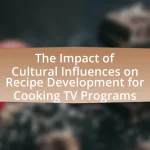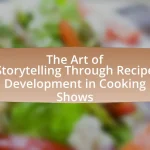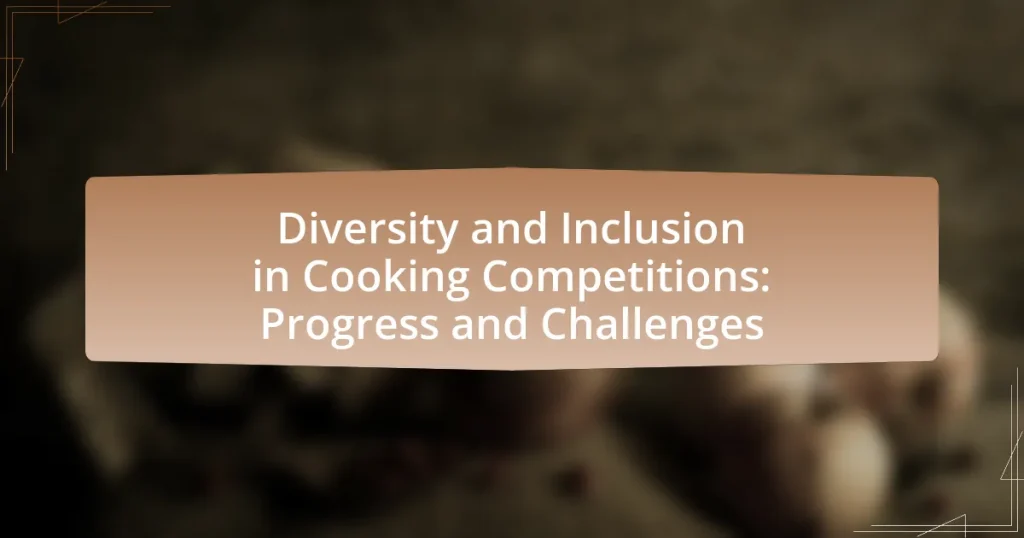Diversity and inclusion in cooking competitions refer to the efforts aimed at representing individuals from various backgrounds, cultures, and identities within the culinary field. This article explores the significance of diversity and inclusion, highlighting their impact on creativity, participant experiences, and societal implications. It examines historical perspectives, current trends, and the evolution of cooking competitions regarding inclusivity, while also addressing the challenges and barriers faced by underrepresented groups. Additionally, the article outlines best practices for promoting diversity and inclusion, including mentorship programs and community engagement, and discusses the role of judges and organizers in fostering an equitable environment.
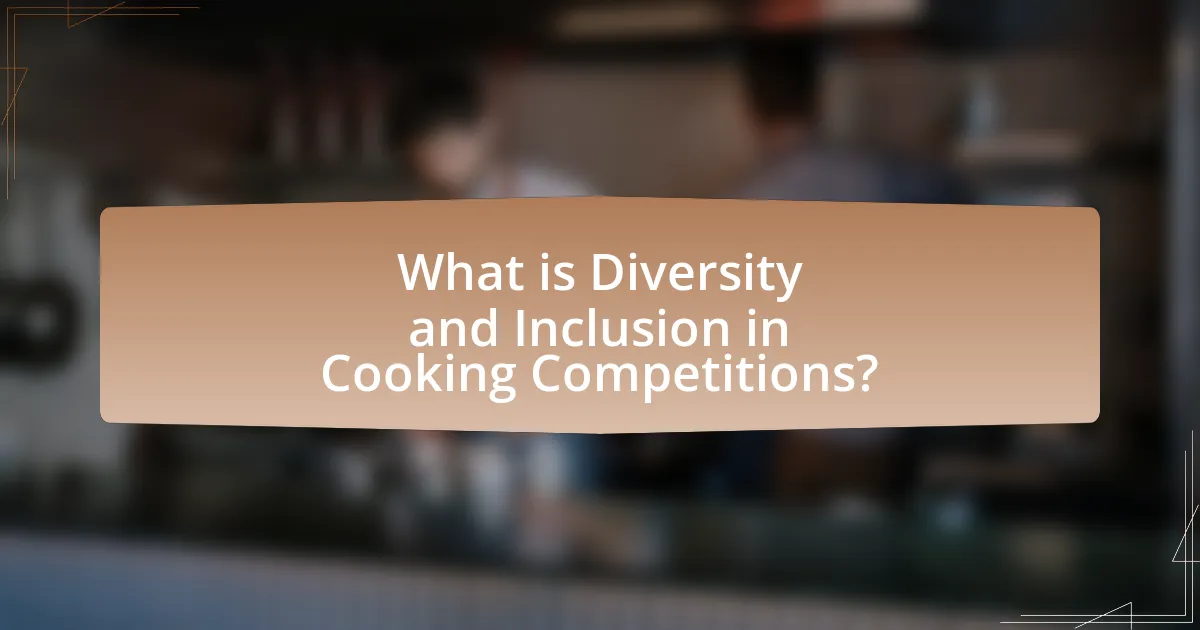
What is Diversity and Inclusion in Cooking Competitions?
Diversity and inclusion in cooking competitions refer to the intentional efforts to represent and engage individuals from various backgrounds, cultures, and identities within the culinary field. This concept aims to create an equitable environment where participants of different races, genders, ethnicities, abilities, and socioeconomic statuses can compete and showcase their culinary skills. Evidence of this focus can be seen in initiatives by organizations like the James Beard Foundation, which promotes diversity through programs that support underrepresented chefs and culinary professionals, highlighting the importance of varied perspectives in enriching the culinary landscape.
Why is Diversity and Inclusion important in Cooking Competitions?
Diversity and inclusion are important in cooking competitions because they foster creativity and innovation by bringing together a wide range of culinary perspectives and techniques. When participants from diverse backgrounds share their unique flavors and cooking styles, it enhances the overall quality of the competition and reflects a broader representation of culinary arts. Research indicates that diverse teams are more effective and produce better outcomes; for instance, a study by McKinsey & Company found that companies with higher diversity levels are 35% more likely to outperform their competitors. This principle applies to cooking competitions as well, where varied cultural influences can lead to more exciting and dynamic dishes, ultimately enriching the culinary landscape.
How does Diversity and Inclusion impact participant experiences?
Diversity and Inclusion significantly enhance participant experiences by fostering a sense of belonging and encouraging varied perspectives. When participants from diverse backgrounds engage in cooking competitions, they bring unique culinary traditions and techniques, enriching the overall experience for everyone involved. Research indicates that diverse teams are more innovative and effective; for instance, a study by McKinsey & Company found that companies with higher diversity levels are 35% more likely to outperform their competitors in profitability. This diversity not only improves creativity but also promotes mutual respect and understanding among participants, leading to a more collaborative and enjoyable environment.
What are the societal implications of Diversity and Inclusion in this context?
The societal implications of Diversity and Inclusion in cooking competitions include enhanced representation, cultural exchange, and the promotion of equity within the culinary arts. Increased representation allows for a broader range of culinary traditions and techniques to be showcased, enriching the overall competition experience. Cultural exchange fosters understanding and appreciation among diverse participants, which can lead to innovative culinary creations that reflect a variety of backgrounds. Furthermore, promoting equity in these competitions can challenge systemic biases and create opportunities for underrepresented groups, ultimately contributing to a more inclusive society. Research indicates that diverse teams often outperform homogeneous ones, as they bring varied perspectives that enhance creativity and problem-solving (Page, S. E. “The Difference: How the Power of Diversity Creates Better Groups, Firms, Schools, and Societies,” 2007).
What are the historical perspectives on Diversity and Inclusion in Cooking Competitions?
Historical perspectives on diversity and inclusion in cooking competitions reveal a gradual evolution from exclusionary practices to more inclusive frameworks. Initially, many cooking competitions predominantly featured chefs from specific cultural backgrounds, often favoring Western culinary traditions, which limited representation and diversity. Over the years, there has been a notable shift, particularly since the late 20th century, as competitions began to recognize the value of diverse culinary perspectives and the importance of inclusivity.
For instance, the introduction of shows like “Top Chef” in 2006 highlighted chefs from various ethnic backgrounds, showcasing a broader range of culinary styles and techniques. This shift has been supported by research indicating that diverse teams produce more innovative solutions, which is particularly relevant in the culinary arts. Furthermore, organizations such as the James Beard Foundation have actively promoted diversity initiatives, emphasizing the need for equitable representation in the culinary field. These historical changes reflect a growing acknowledgment of the importance of diversity and inclusion in enriching the culinary landscape.
How have cooking competitions evolved regarding Diversity and Inclusion?
Cooking competitions have evolved significantly regarding diversity and inclusion by increasingly featuring contestants from varied cultural backgrounds and promoting diverse culinary traditions. For instance, shows like “Top Chef” and “MasterChef” have made concerted efforts to include chefs from underrepresented communities, showcasing a wider array of cuisines and cooking styles. This shift is evidenced by the growing number of contestants of color and the inclusion of LGBTQ+ chefs, reflecting broader societal changes and a commitment to representation. Additionally, initiatives such as mentorship programs and partnerships with organizations focused on diversity in the culinary arts further support this evolution, aiming to create a more inclusive environment within the competitive cooking landscape.
What milestones have been achieved in promoting Diversity and Inclusion?
Significant milestones in promoting Diversity and Inclusion in cooking competitions include the establishment of diverse judging panels, which has increased representation of various cultural backgrounds, and the implementation of initiatives aimed at supporting underrepresented chefs. For instance, the introduction of programs like “Diversity in Culinary Arts” has provided scholarships and mentorship opportunities for aspiring chefs from marginalized communities. Additionally, major competitions have begun to feature categories specifically celebrating diverse cuisines, reflecting a broader acceptance and appreciation of culinary diversity. These efforts have been documented in reports from organizations such as the James Beard Foundation, which highlights the positive impact of inclusive practices on the culinary industry.
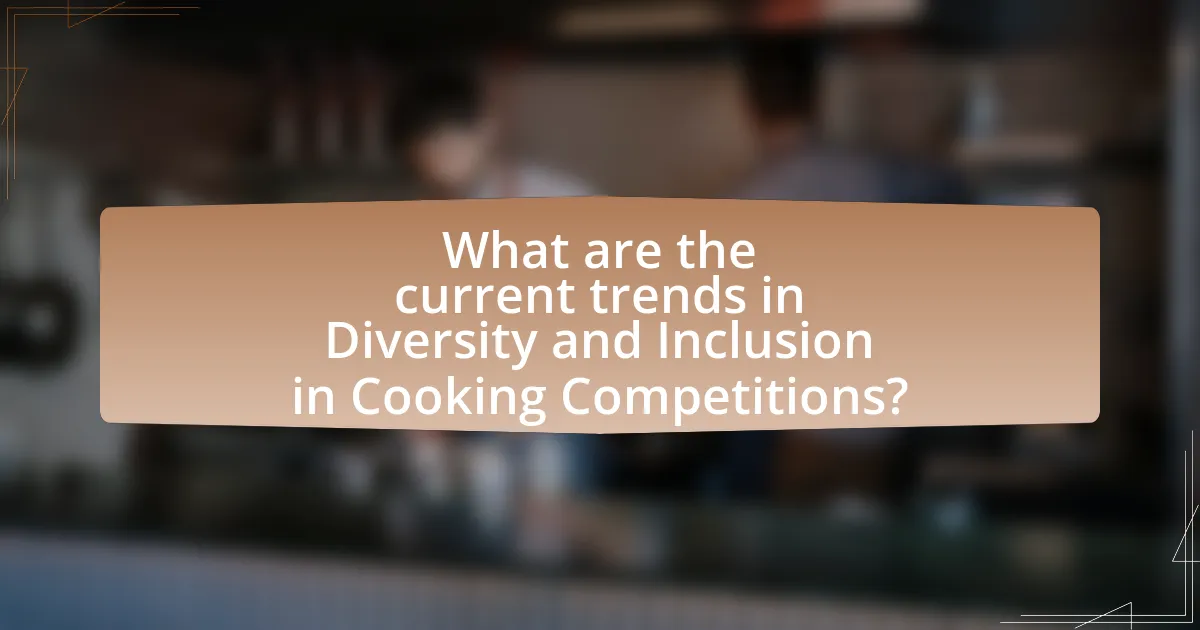
What are the current trends in Diversity and Inclusion in Cooking Competitions?
Current trends in diversity and inclusion in cooking competitions emphasize the representation of underrepresented groups, including women, people of color, and LGBTQ+ individuals. Recent competitions have actively sought to diversify their contestant pools, reflecting broader societal movements towards equity. For instance, shows like “Top Chef” and “MasterChef” have featured contestants from various cultural backgrounds, showcasing diverse culinary traditions and perspectives. Additionally, initiatives such as mentorship programs and partnerships with organizations focused on culinary education for marginalized communities are becoming more common, aiming to create pathways for aspiring chefs. These trends are supported by statistics indicating that diverse teams often lead to more innovative and successful outcomes in culinary arts, reinforcing the importance of inclusion in fostering creativity and excellence.
How are cooking competitions adapting to promote Diversity and Inclusion?
Cooking competitions are adapting to promote diversity and inclusion by actively incorporating diverse culinary traditions and featuring contestants from various cultural backgrounds. For instance, many competitions now include specific categories that celebrate regional cuisines and encourage participation from underrepresented groups, thereby broadening the scope of culinary representation. Additionally, organizations are implementing mentorship programs aimed at supporting chefs from marginalized communities, which fosters an inclusive environment. Research indicates that such initiatives not only enhance creativity and innovation in culinary arts but also reflect the growing consumer demand for diverse food experiences.
What initiatives are being implemented to enhance Diversity and Inclusion?
Initiatives being implemented to enhance Diversity and Inclusion in cooking competitions include targeted outreach programs, mentorship opportunities, and diverse judging panels. Targeted outreach programs aim to engage underrepresented communities by promoting participation through workshops and informational sessions. Mentorship opportunities connect aspiring chefs from diverse backgrounds with established professionals, fostering skill development and networking. Diverse judging panels ensure that a variety of perspectives are represented, which can lead to more equitable evaluations of participants. These initiatives are supported by organizations that recognize the importance of inclusivity in the culinary arts, contributing to a more representative and fair competition landscape.
How are judges and organizers addressing Diversity and Inclusion?
Judges and organizers are addressing Diversity and Inclusion by implementing specific criteria and practices that promote equitable representation in cooking competitions. For instance, many competitions now require diverse judging panels that reflect various backgrounds, ensuring that different culinary traditions and perspectives are valued. Additionally, organizers are actively seeking participants from underrepresented communities through outreach programs and partnerships with organizations that support diversity in the culinary field. These efforts are supported by data indicating that diverse teams lead to more innovative and creative outcomes, enhancing the overall quality of the competition.
What challenges remain in achieving Diversity and Inclusion in Cooking Competitions?
Challenges in achieving diversity and inclusion in cooking competitions include systemic biases, lack of representation, and limited access to resources. Systemic biases often manifest in judging criteria that favor traditional culinary styles, which can disadvantage participants from diverse backgrounds. Additionally, many competitions lack representation of various cultures, leading to a narrow view of culinary excellence. Limited access to resources, such as funding, mentorship, and training opportunities, further exacerbates these challenges, making it difficult for underrepresented chefs to compete effectively. These factors collectively hinder the progress toward a more inclusive environment in cooking competitions.
What barriers do underrepresented groups face in these competitions?
Underrepresented groups face significant barriers in cooking competitions, including limited access to resources, lack of representation in judging panels, and systemic biases. Limited access to resources, such as funding for training and ingredients, restricts their ability to compete effectively. Additionally, the lack of diversity among judges can lead to biased evaluations, as judges may favor familiar culinary styles over those from underrepresented cultures. Systemic biases in the culinary industry further perpetuate these challenges, making it difficult for individuals from these groups to gain recognition and opportunities. Studies have shown that diverse representation in culinary competitions can enhance creativity and innovation, highlighting the need for inclusive practices to overcome these barriers.
How do biases affect the outcomes of cooking competitions?
Biases significantly affect the outcomes of cooking competitions by influencing judges’ perceptions and decisions based on factors unrelated to culinary skill. Research indicates that implicit biases, such as those related to race, gender, or cultural background, can lead judges to favor contestants who fit certain stereotypes or expectations, rather than objectively evaluating their cooking abilities. For instance, a study published in the Journal of Culinary Science & Technology found that judges often unconsciously rated dishes prepared by contestants from familiar cultural backgrounds higher than those from less familiar ones, regardless of the actual quality of the dishes. This demonstrates how biases can skew competition results, ultimately impacting the representation and success of diverse chefs in the culinary field.
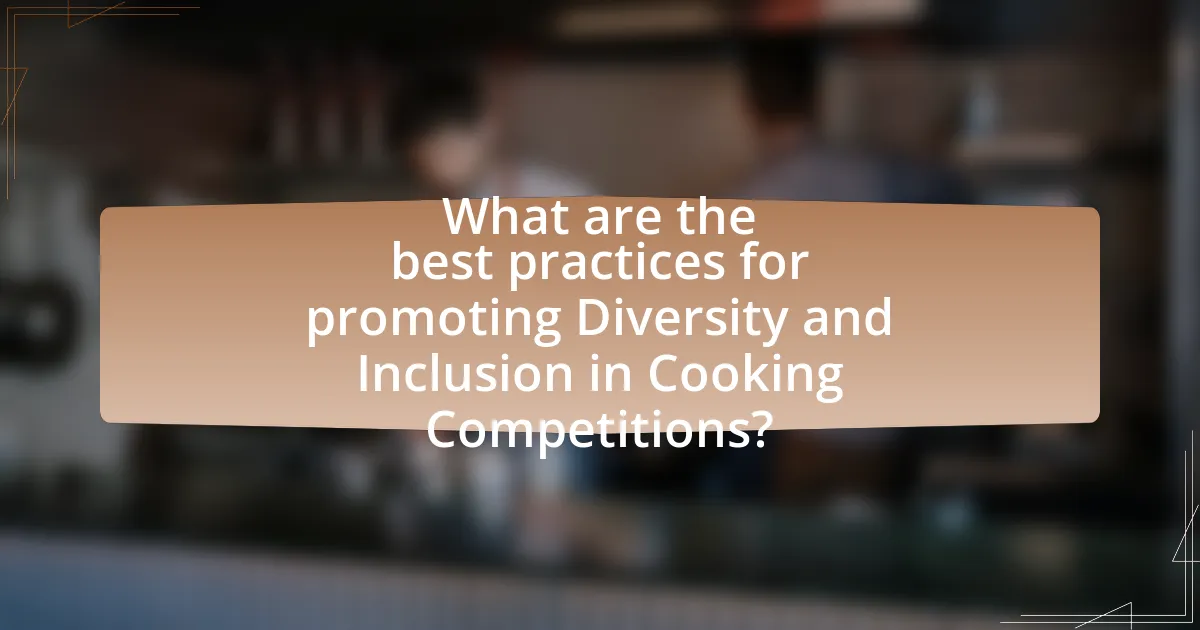
What are the best practices for promoting Diversity and Inclusion in Cooking Competitions?
The best practices for promoting diversity and inclusion in cooking competitions include implementing equitable selection processes, providing mentorship opportunities, and ensuring diverse representation in judging panels. Equitable selection processes can be achieved by actively recruiting participants from underrepresented communities, which helps to create a more inclusive environment. Mentorship opportunities can support aspiring chefs from diverse backgrounds, fostering their skills and confidence in a competitive setting. Additionally, having diverse judging panels not only reflects a range of culinary perspectives but also enhances the credibility and relatability of the competition. These practices are supported by research indicating that diversity leads to improved creativity and innovation in culinary arts, as diverse teams bring varied experiences and viewpoints to the table.
How can organizers create a more inclusive environment?
Organizers can create a more inclusive environment by implementing diverse recruitment strategies that actively seek participants from various backgrounds. Research indicates that diverse teams enhance creativity and problem-solving, which is crucial in cooking competitions. For instance, a study by the Harvard Business Review found that companies with higher diversity levels are 35% more likely to outperform their competitors. Additionally, providing accessible resources, such as language support and dietary accommodations, ensures that all participants can engage fully. By fostering an atmosphere of respect and understanding, organizers can promote collaboration and innovation among competitors, ultimately enriching the competition experience.
What role does community engagement play in fostering Diversity and Inclusion?
Community engagement plays a crucial role in fostering diversity and inclusion by actively involving diverse groups in decision-making processes and creating a sense of belonging. Engaging communities allows for the representation of various cultural perspectives, which enriches the dialogue and practices within cooking competitions. For instance, initiatives that invite local chefs from different backgrounds to participate in events not only showcase diverse culinary traditions but also promote understanding and appreciation among participants and audiences. Research indicates that organizations that prioritize community engagement in their diversity strategies see improved outcomes in participant satisfaction and increased innovation, as diverse teams bring varied ideas and solutions to the table.
How can mentorship programs support underrepresented chefs?
Mentorship programs can support underrepresented chefs by providing them with access to industry knowledge, networking opportunities, and skill development. These programs often connect emerging chefs with experienced professionals who can offer guidance on culinary techniques, business acumen, and navigating the competitive landscape of the culinary world. For instance, a study by the James Beard Foundation found that mentorship significantly increases the likelihood of career advancement for underrepresented individuals in the culinary field, highlighting the importance of these relationships in fostering diversity and inclusion.
What practical steps can participants take to advocate for Diversity and Inclusion?
Participants can advocate for Diversity and Inclusion by actively promoting diverse culinary representation in cooking competitions. This can be achieved by encouraging the inclusion of chefs from various cultural backgrounds, which enriches the competition and reflects a broader range of culinary traditions. Research indicates that diverse teams lead to more innovative solutions and better performance, as highlighted in a study by McKinsey & Company, which found that companies in the top quartile for ethnic diversity are 35% more likely to outperform their peers. Additionally, participants can engage in mentorship programs that support underrepresented chefs, fostering an inclusive environment that empowers diverse talent. By collaborating with organizations that focus on diversity initiatives, participants can amplify their advocacy efforts and create a more equitable platform within the culinary community.
How can chefs use their platforms to promote inclusivity?
Chefs can use their platforms to promote inclusivity by showcasing diverse culinary traditions and highlighting underrepresented voices in the food industry. By featuring recipes, techniques, and stories from various cultures, chefs can educate their audiences about the richness of global cuisines. For instance, initiatives like the “Diverse Chefs Coalition” aim to amplify the contributions of chefs from marginalized backgrounds, demonstrating that inclusivity can enhance culinary creativity and innovation. Additionally, chefs can collaborate with organizations that support diversity, such as mentorship programs for aspiring chefs from diverse backgrounds, thereby fostering a more inclusive culinary community.
What resources are available for chefs to learn about Diversity and Inclusion?
Chefs can access various resources to learn about Diversity and Inclusion, including online courses, workshops, and industry publications. For instance, organizations like the James Beard Foundation offer programs focused on equity and inclusion in the culinary field. Additionally, platforms such as Coursera and edX provide courses on diversity training that are applicable to the culinary industry. Industry publications like “Food & Wine” and “Bon Appétit” often feature articles and insights on diversity initiatives within restaurants and cooking competitions. These resources collectively support chefs in understanding and implementing diversity and inclusion practices in their work environments.


